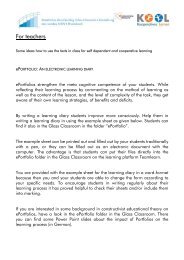ERSTER ZWISCHENBERICHT - e-Learning-Portal
ERSTER ZWISCHENBERICHT - e-Learning-Portal
ERSTER ZWISCHENBERICHT - e-Learning-Portal
Sie wollen auch ein ePaper? Erhöhen Sie die Reichweite Ihrer Titel.
YUMPU macht aus Druck-PDFs automatisch weboptimierte ePaper, die Google liebt.
Staatliches Berufskolleg Glas ● Keramik ● Gestaltung<br />
des Landes NRW ● Rheinbach<br />
7.3.5 Arbeitsblätter des WBT „English for Glass Professionals“<br />
How to write a summary<br />
What is a summary? It is a brief restatement – IN YOUR OWN WORDS – of the contents of a passage.<br />
You simply report back what the other writer has said. It is not your job to make value judgements about<br />
the "rightness" or "wrongness" of what (s)he says. That would be a different kind of paper – a summaryresponse,<br />
a critique, or a position paper. A guideline for length: many good summaries are about 1/4 to<br />
1/3 the length of the original.<br />
What are the steps in writing a summary?<br />
1. Read the passage carefully. Analyse its structure. Identify the author's intention in writing. This will<br />
help you to distinguish between more important and less important information.<br />
2. Reread and underline. This time divide the passage into sections of thought. The author's use of<br />
paragraphing will often be a useful guide. Label, on the passage itself, each section of thought.<br />
Underline key ideas and terms.<br />
3. Write one-sentence summaries, on a separate sheet of paper, of each stage of thought. If you<br />
have trouble doing this, you might try writing a summary sentence for each paragraph and then<br />
revising where you see yourself repeating ideas. You may find it useful to keep in mind the<br />
information contained in the lead sentence or paragraph of most newspaper stories – the what,<br />
who, why, where, when, and how of the matter. Put the author's ideas into your own words!<br />
4. Write the first draft of your summary, including the following aspects in the first two sentences: 1)<br />
the author’s name, 2) the text’s title, and 3) the author’s main idea or thesis statement. After that<br />
you combine the thesis with your list of one-sentence summaries. Eliminate repetition and less<br />
important information.<br />
5. Check your summary against the original passage, and make whatever adjustments are necessary<br />
for accuracy and completeness.<br />
6. Revise your summary, inserting transitional words and phrases where necessary to ensure<br />
coherence (like “in addition”, “moreover”, “although”, “on the other hand”, “however”, “finally”,<br />
“consequently”). Check for style. Combine sentences for a logical flow of ideas. Check for<br />
grammatical correctness, punctuation, and spelling.<br />
Vocabulary:<br />
brief = kurz to divide = unterteilen<br />
restatement = Neuformulierung section of thought = Gedankenpassage<br />
passage = Absatz to revise = überarbeiten<br />
content = Inhalt paragraphing = Absätze machen<br />
value judgement = Werturteil useful = nützlich<br />
response = Antwort guide = Leiter/Anleitung<br />
intention = Absicht to label = kennzeichnen<br />
to distinguish = unterscheiden key ideas and terms = Schlüsselideen u. -begriffe<br />
reread = wiederlesen to contain = enthalten/beinhalten<br />
lead sentence = Einleitungssatz matter = Angelegenheit<br />
draft = Entwurf thesis = These, Behauptung<br />
statement = Behauptung to eliminate = beseitigen/entfernen<br />
adjustment = Angleichung accuracy = Fehlerfreiheit/Präzision<br />
transitional words = Übergangswörter coherence = logischer Zusammenhang<br />
Seite 119






